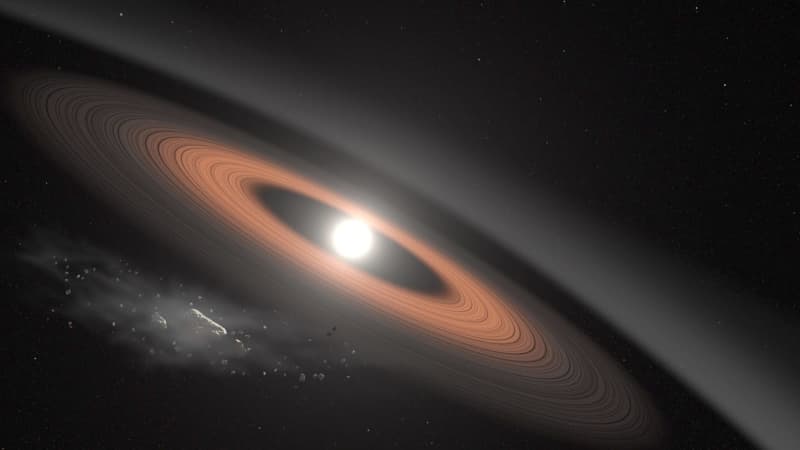Astronomers recently peered deep into space and found that an old, faint white dwarf named LSPM J0207+3331, located about 145 light-years away, is still consuming the rocky remains of its former planets. This star, about the size of Earth but with half the Sun’s mass, has been cooling for roughly 3 billion years. Yet it’s actively pulling in planetary debris today, offering a rare and direct glimpse into the chemistry of destroyed exoplanets and the long, messy afterlife of planetary systems.
Spectroscopic observations using Hawaii’s W. M. Keck Observatory revealed a surprising amount of heavy elements—13 in total—lingering in the star’s thin hydrogen atmosphere. These include iron, nickel, magnesium, silicon, calcium, and even rarer elements like strontium. Ordinarily, such metals would sink out of sight within tens of thousands of years, meaning the star must still be accreting new debris right now.
“This discovery challenges our understanding of planetary system evolution,” said lead author Érika Le Bourdais of the Trottier Institute for Research on Exoplanets at Université de Montréal. “Ongoing accretion at this stage suggests white dwarfs may also retain planetary remnants still undergoing dynamical changes.”
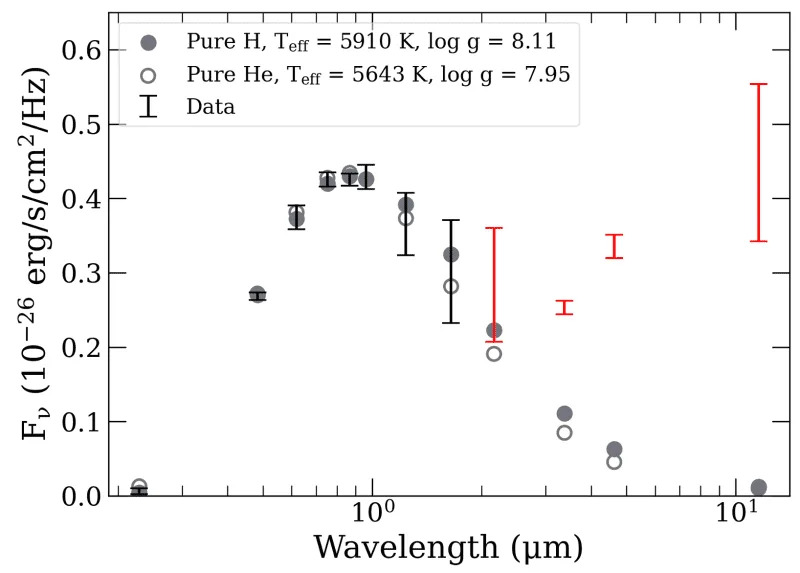
Photometric fit for LSPM J0207+3331. All spectral bands listed in Table 1 are shown with error bars. The best-fit pure hydrogen model (filled circles) is compared to a pure helium model (open circles). (CREDIT: Astrophysical Journal Letters)
A Forensic Look at a Destroyed Planet
By analyzing the star’s light, scientists reconstructed the chemical “fingerprints” of the material falling into it. They found a composition remarkably similar to Earth’s—dry, rocky, and rich in metals like iron and nickel that form planetary cores. The ratios of magnesium, silicon, and iron suggest the parent body was once differentiated, with a metal core making up about 55 percent of its mass—denser than Earth’s.
The shattered object was likely at least 225 kilometers in radius, about the size of a mid-sized asteroid or small dwarf planet. At one point, gravitational disturbances—possibly from a surviving outer planet or a passing star—may have nudged this ancient world inward, where tidal forces tore it apart. Its fragments now swirl around the white dwarf in a dense, dusty ring, slowly spiraling into the star.
“The amount of rocky material is unusually high for a white dwarf of this age,” noted co-author Patrick Dufour of Université de Montréal. “Something clearly disturbed this system long after the star’s death.”
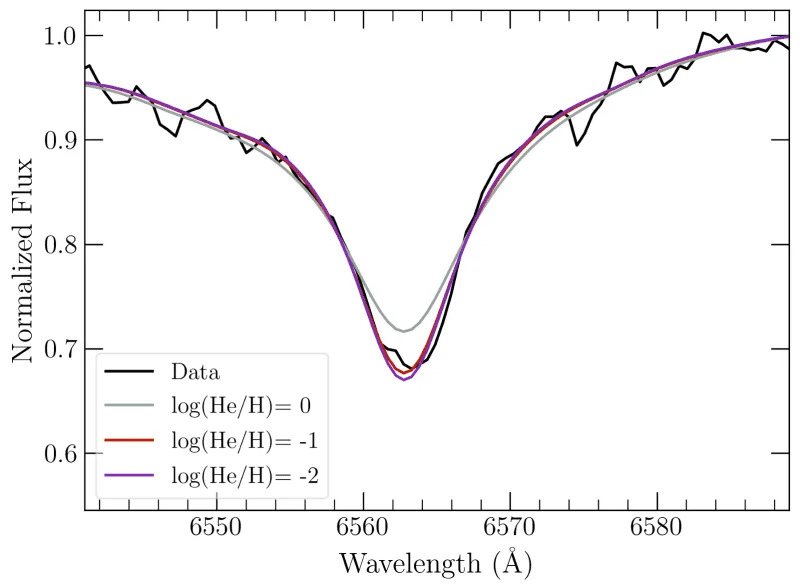
Models covering Hα with He abundances of log(He/H) = −2, −1, and 0 overplotted on the MagE spectrum. (CREDIT: Astrophysical Journal Letters)
A Dusty Disk and a Faint Stellar Glow
Infrared observations also revealed that LSPM J0207+3331 shines unusually bright in mid-infrared light, a clue to the dusty ring of debris encircling it. Researchers modeled this disk as a single, silicate-rich band located just a few dozen stellar radii from the white dwarf’s surface. It contains about 5 × 10¹⁹ grams of dust, likely produced as the fragments grind and vaporize over time.
A subtle calcium emission line seen in the star’s spectrum added another twist. This faint glow, rarely observed in such cool white dwarfs, could indicate a weakly heated upper atmosphere or gentle magnetic activity triggered by infalling debris. Though small, it hints that even long-dead stars can show a flicker of atmospheric energy.
How Astronomers Modeled the Star’s Messy Atmosphere
The team also uncovered a methodological surprise. Typically, astronomers determine a white dwarf’s properties using simple models of pure hydrogen atmospheres, then add metals afterward to match observed spectral lines. But in this case, the atmosphere was so heavily polluted that the metals themselves changed the star’s temperature and pressure structure.
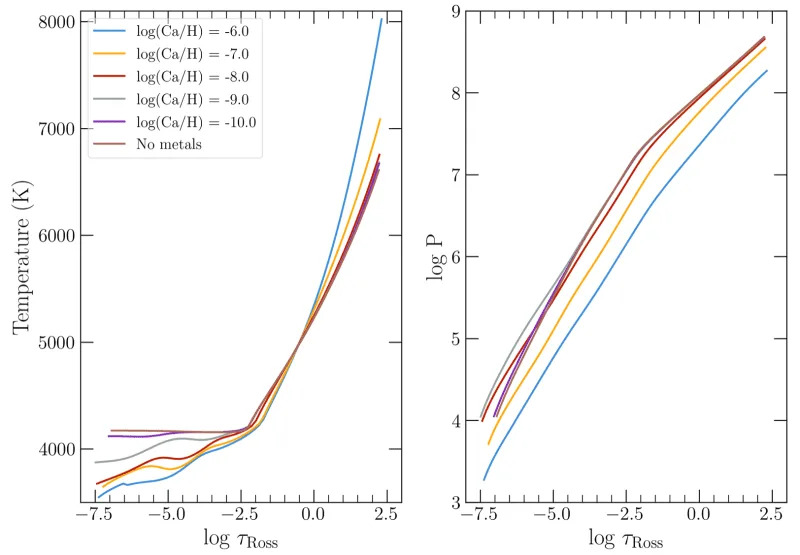
Temperature (left) and pressure (right) structure as a function of the optical depth for a hydrogen-rich white dwarf model with Teff = 5000 K and log g = 8.0. (CREDIT: Astrophysical Journal Letters)
When the researchers rebuilt the models to include metals from the start, the simulated spectrum matched perfectly. Without this correction, they found that temperatures could be underestimated by more than 100 Kelvin and surface gravity by up to 0.2 dex. The lesson, they said, is clear: for cool, metal-rich white dwarfs, heavy elements aren’t just decoration—they reshape the entire atmosphere.
The Long Afterlife of Planetary Systems
LSPM J0207+3331 offers a haunting preview of what might one day happen to our own solar system. In about 5 billion years, the Sun will exhaust its hydrogen, swell into a red giant, and collapse into a dense white dwarf. Earth and its neighbors will be stripped, scorched, and possibly torn apart. Yet as this discovery shows, remnants of those worlds may continue to drift inward for billions of years, keeping the Sun’s ghostly remains surrounded by a ring of planetary dust.
“This suggests tidal disruption and accretion mechanisms remain active long after a star’s main-sequence life,” said co-author John Debes of the Space Telescope Science Institute. “Mass loss during stellar evolution can destabilize orbits, affecting planets, comets, and asteroids.”
Astronomers now suspect that nearly half of all white dwarfs show similar “pollution,” indicating that their planetary systems remain active long after stellar death. Future missions like NASA’s James Webb Space Telescope and ESA’s Gaia could detect surviving giant planets or faint gravitational influences around these dying stars, providing clues about what stirs the debris so long after the main event.
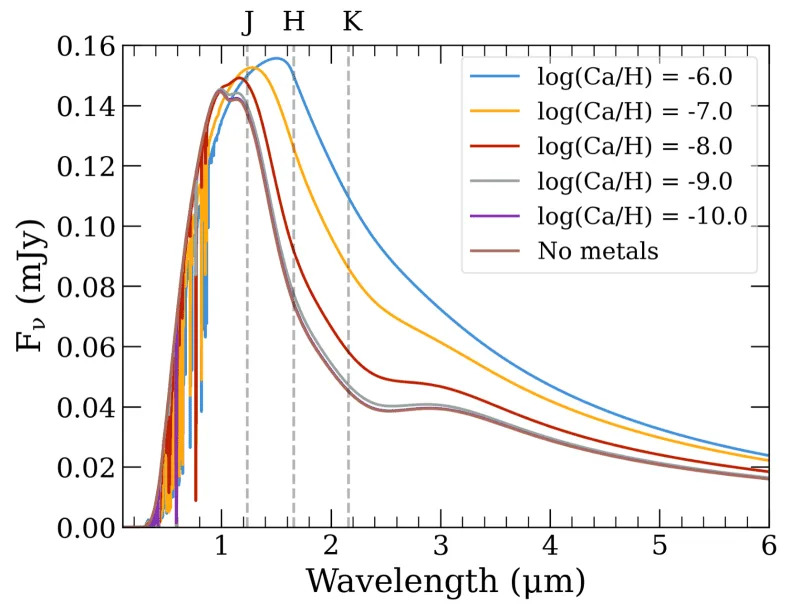
Spectral energy distribution for a model white dwarf with Teff = 4000 K and log g = 8.0 for various metallicities. The 2MASS JHKs spectral bands are indicated by dashed lines. (CREDIT: Astrophysical Journal Letters)
Practical Implications of the Research
This discovery redefines how scientists view the final stages of planetary evolution. It shows that even ancient systems can experience renewed dynamical activity and that white dwarfs serve as natural laboratories for studying the chemical makeup of rocky exoplanets.
By analyzing how these remnants fall into stellar corpses, researchers can directly sample the building blocks of alien worlds—an impossible task with intact planets.
For humanity, this cosmic autopsy offers a forecast of our solar system’s far future. It reminds us that stars and their planets share long, intertwined fates—and that even in death, the remnants of worlds can still whisper their stories across light-years.
Research findings are available online in The Astrophysical Journal.
Related Stories
Like these kind of feel good stories? Get The Brighter Side of News’ newsletter.

